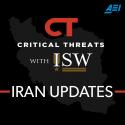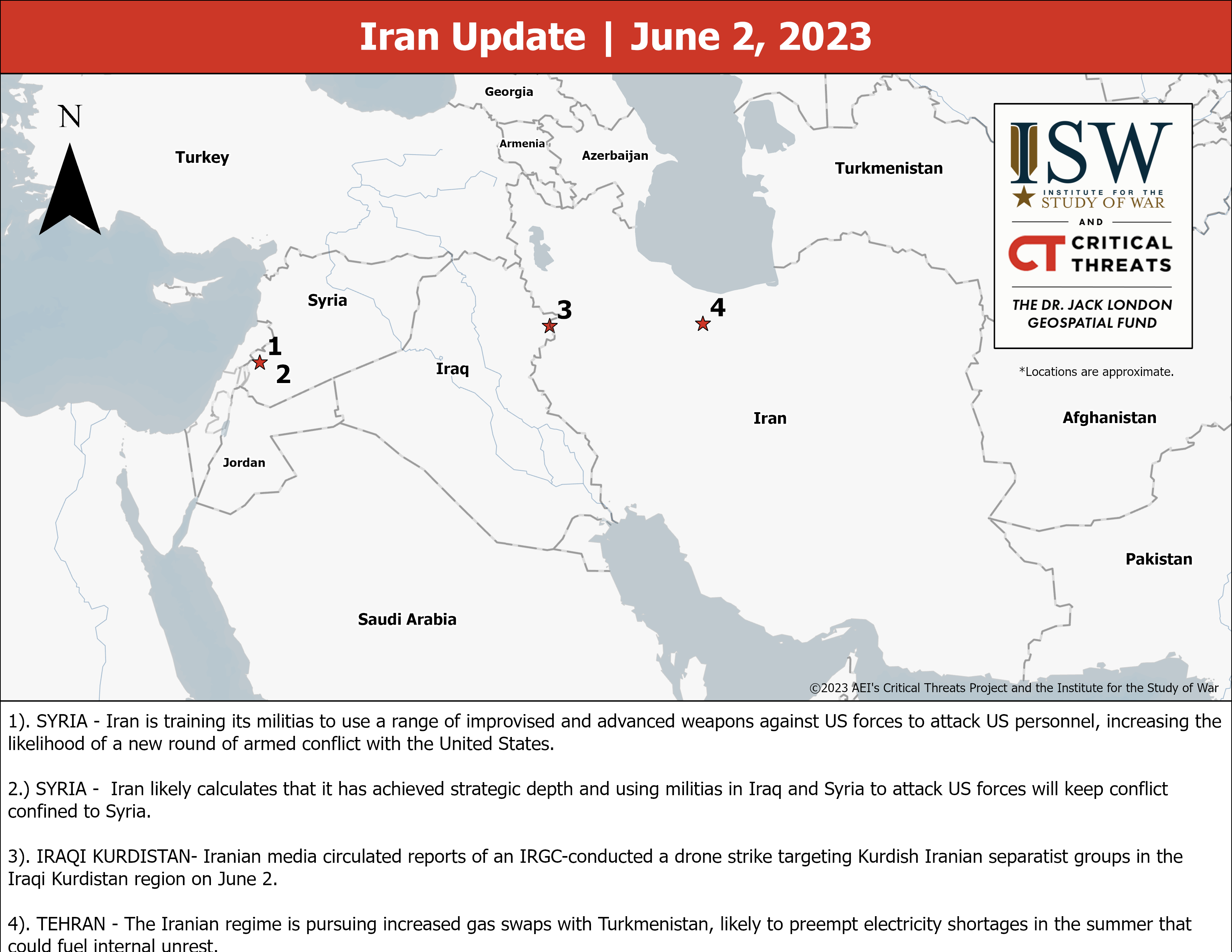 |
 |
Iran Update, June 2, 2023

Iran Update, June 2, 2023
Annika Ganzeveld, Andie Parry, Ashka Jhaveri, Johanna Moore, and Kitaneh Fitzpatrick
The Iran Update aims to inform national security policy by providing timely, relevant, and independent open-source analysis of developments pertaining to Iran and its Axis of Resistance. This update covers political, military, and economic events and trends that affect the stability and decision-making of the Iranian regime. It also provides insights into Iranian and Iranian-sponsored activities abroad that undermine regional stability and threaten US forces and interests. The Critical Threats Project (CTP) at the American Enterprise Institute with support from the Institute for the Study of War (ISW) provides these updates Monday through Friday. To receive Iran Updates via email, please subscribe here.
Key Takeaways
1). Iran is training its militias in Syria to use a range of improvised and advanced weapons to attack US personnel in Syria. Iranian-backed militias in Iraq may conduct attacks against US forces in Syria.
2). Iran likely calculates that it has achieved strategic depth and using militias in Iraq and Syria to attack US forces will keep conflict confined to Syria.
3). Iranian media circulated reports of an IRGC-conducted a drone strike targeting Kurdish Iranian separatist groups in the Iraqi Kurdistan region on June 2.
4). The Iranian regime is pursuing increased gas swaps with Turkmenistan, likely to preempt electricity shortages in the summer that could fuel internal unrest.
Iranian Activities in the Levant
This section covers Iranian efforts to consolidate and expand Tehran’s economic, military, and political influence throughout the Levant and especially in Syria. This section examines some of the many campaigns that Iran is pursuing to achieve this strategic objective. CTP will update and refine our assessments of these campaigns over time and in future updates.
Iran is training its militias in Syria to use a range of improvised and advanced weapons to attack US personnel in Syria. Iran and Lebanese Hezbollah (LH) have trained militias since January to construct and begin using explosively formed penetrators (EFPs) against US forces in Syria.[1] Iranian-backed militias killed at least 603 US personnel in Iraq with EFPs from 2003 to 2011.[2] Iranian Quds Force leaders in Deir ez Zor ordered surface-to-surface missile and man portable air defense system training for a local proxy group in late May.[3] CTP cannot independently verify the report about surface-to-surface missiles. Iranian-backed militias also have received training on drones, which enabled them to conduct an ISR flight over the US Conoco Base in Deir ez Zor Province in February and target other US bases in Syria with attack UAVs.[4] Iranian-backed militias have also accelerated the training and use of drone capabilities in Deir ez Zor Province since April.[5] These capabilities enable Iranian-backed militias to carry out attacks on US bases, ground forces, and helicopters in Syria. [6] That the SDF seized three EFPs near a US base in northeast Syria indicates the imminent threat that Iranian proxies armed with EFPs pose to US forces.[7]
Iranian-backed militias in Iraq may conduct attacks against US forces in Syria. The Iranian-backed militia Kataib al Sabreen announced its formation and intention to target US forces in Iraq on June 1.[8] The Asaib Ahl al Haq and Harakat al Nujaba-affiliated group Ashab al Kahf announced it has ordered its rocket unit operating in Mosul to redeploy to Baghdad to attack US forces at Camp Victory and the US Embassy.[9] The Iraq-based Iranian proxy group Liwa al Ghaliboun killed a US contractor in an attack on US forces in Syria on March 23.[10]
Iran likely calculates that it has achieved strategic depth and using militias in Iraq and Syria to attack US forces will keep conflict confined to Syria. Iranian-backed militias have previously attacked US forces from positions in Iraq and Syria.[11] US forces retaliated with attacks against Iranian-backed militia positions in Syria. Using proxies to attack US forces obfuscates Iran’s role and gives it plausible deniability. Iranian calculations to target US forces in Syria aligns with Iran’s goals in preventing an attack on Iran and Iran’s offensive regional strategy.[12]
Iranian Activities in Iraq
This section covers Iranian efforts to consolidate and expand Tehran’s economic, military, and political influence throughout Iraq. This section examines some of the many campaigns that Iran is pursuing to achieve this strategic objective. CTP will update and refine our assessments of these campaigns over time and in future updates.
Iranian media circulated reports of an IRGC-conducted a drone strike targeting Kurdish Iranian separatist groups in the Iraqi Kurdistan region on June 2. Iranian English-language news outlet West Asia News Agency cited unidentified Iranian outlets claiming that the IRGC bombed headquarters of Kurdish Iranian separatist groups in Iraqi Kurdistan.[13] Iranian-backed proxy Telegram channels circulated the report and added that the IRGC had targeted the separatist groups in a drone strike.[14] Iranian media has not yet reported on this incident, which deviates from the regime’s regular pattern of reporting on Iranian strikes targeting Kurdish separatist groups in Iraqi Kurdistan.
Iranian Domestic Affairs
This section covers factors and trends affecting regime decision-making and stability. CTP will cover domestic politics, significant protest activity, and related issues here.
The Iranian regime is pursuing gas swaps with Turkmenistan, likely to preempt electricity shortages in the summer that could fuel internal unrest. President Ebrahim Raisi discussed increasing the volume of gas swaps with Turkmenistan during a meeting with Turkmenistan People’s Council Chairman Gurbanguly Berdymukhamedov in Tehran on May 30.[15] Iranian Oil Minister Javad Owji separately announced on May 30 that Iran and Turkmenistan will soon sign an agreement for Iran to import 10 million cubic meters of natural gas from Turkmenistan each day.[16] Azerbaijan, Iran, and Turkmenistan previously signed a gas swap agreement in November 2021 wherein Iran transports Turkmen gas to Azerbaijan via the Iranian city of Astara.[17] This deal allows Iran to use some of the gas it imports from Turkmenistan to supply electricity and heating to its northern provinces. Iranians previously protested power outages in Tehran, Fars, and Mazandaran Provinces in July 2021.[18]
Iranian officials also discussed water problems with Berdymukhamedov on May 30. President Ebrahim Raisi praised Iranian-Turkmen water cooperation and discussed the Friendship Dam—a dam situated along the Iran-Turkmenistan border in Khorasan Razavi Province—during a meeting with high-ranking Turkmen and Iranian officials on May 30.[19] Iranian officials have expressed increased concern over Khorasan Razavi Province’s water supply in recent weeks.[20] Iran’s water discussions with Turkmenistan also coincide with rising tensions over water rights between Iran and Afghanistan. The Raisi administration has placed greater pressure on the Afghan Taliban to release water from the Helmand River to Sistan and Baluchistan Province in recent weeks because it is concerned that water shortages could precipitate unrest in this province.[21]
Iran could decrease the volume of natural gas it keeps from gas swaps with Turkmenistan to gain water concessions. The Turkmen government has no incentive to provide Iran with more water, however, given that many Turkmen farmers rely on the Friendship Dam for water. A regime decision to risk natural gas imports for water concessions would indicate that Iran currently prioritizes water issues over energy issues.
Iranian security personnel violently suppressed an anti-regime demonstration in Abdanan, Ilam Province on June 1, demonstrating that protesters remain undeterred from further protest despite the brutal regime crackdown during the Mahsa Amini movement.[22] Social media users reported that security forces shot at and injured at least 20 individuals protesting the suspicious death of 21-year-old Bamshad Soleimankhani, who died shortly after he was released from prison. CTP previously recorded a significant uptick in anti-regime protests in May 2023 compared to April and March of this year.[23]
[2] https://www.criticalthreats.org/analysis/pivot-to-offense-how-iran-is-adapting-for-modern-conflict-and-warfare
[3] https://eyeofeuphrates[dot]com/ar/news/2023/06/01/8699
[4] https://twitter.com/CENTCOM/status/1625676190877876225
[5] https://eyeofeuphrates[dot]com/ar/news/2023/05/04/8403 ; https://eyeofeuphrates.com/ar/news/2023/04/06/8164 ; https://eyeofeuphrates[dot]com/ar/news/2023/05/22/8591 ; https://nahermedia[dot]net/%D8%AA%D9%81%D8%A7%D8%B5%D9%8A%D9%84-%D9%88%D9%81%D8%AF-%D9%85%D9%8A%D9%84%D9%80-%D9%8A%D8%B4%D9%8A%D8%A7-%D8%AD%D9%80-%D9%80%D8%B2%D8%A8-%D8%A7%D9%84%D9%84%D9%87-%D8%A7%D9%84%D8%B0%D9%8A-%D9%88%D8%B5/ ; https://eyeofeuphrates[dot]com/ar/news/2023/05/09/8457 ; https://eyeofeuphrates[dot]com/ar/news/2023/04/26/8319
[7] https://www.washingtonpost.com/world/2023/06/01/discord-leaks-iran-russia-syria/
[8] https://t.me/jbt313/22526
[9] https://twitter.com/Tammuz_Intel/status/1663200934606807040
[10] https://t.me/alghalibun/4
[11] https://www.criticalthreats.org/analysis/iran-update-march-24-2023
[12] https://www.criticalthreats.org/analysis/pivot-to-offense-how-iran-is-adapting-for-modern-conflict-and-warfare
[13] https://t dot co/trR9s7uKUk
[14] https://t.me/sabreenS1/77235
[15] https://president dot ir/fa/144444
[16] https://www.irna dot ir/news/85126979
[17] https://www.reuters.com/markets/commodities/iran-turkmenistan-azerbaijan-sign-gas-swap-deal-2021-11-28/
[18] https://www.bbc.com/news/world-middle-east-57719556
[19] https://president dot ir/fa/144440
[20] https://www.mehrnews dot com/news/5788450
https://www.yjc dot ir/fa/amp/news/8425787
[21] https://www.criticalthreats.org/analysis/iran-update-may-18-2023
